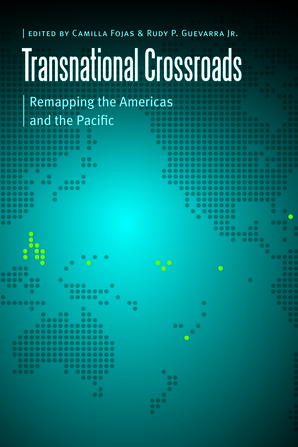Racial, Religious, and Civic Creole Identity in Colonial Spanish AmericaPosted in Articles, Arts, Caribbean/Latin America, Media Archive, Mexico, Religion on 2011-11-30 03:17Z by Steven |
Racial, Religious, and Civic Creole Identity in Colonial Spanish America
The Journal of American History
Volume 17, Issue 3 (Fall 2005)
pages 420-437
DOI: 10.1093/alh/aji024
Jorge Cañizares-Esguerra, Alice Drysdale Sheffield Professor of History
University of Texas, Austin
Patrocinio de la Virgen de Guadalupe sobre el Reino de Nueva España (“Auspices of Our Lady of Guadalupe over the Kingdom of New Spain”) (Fig. 1) is an eighteenth-century canvass by an anonymous Mexican painter that rather vividly captures Creole discourses in colonial Mexico. A garlanded Our Lady of Guadalupe stands on top of a fountain from which four kneeling nobles, two indigenous, two Hispanic, drink.
Fountains had long been associated with salvation and purity in Christian discourse. For example, in their 1596 Ghent altarpiece, Fountain of Life and Mercy, Gerard Horenbout (1467–1540) and his son Lucas Horenbout (d. 1544) have the community of the pious drink of a fountain whose source is the body of Christ (Fig. 2). Believers eucharistically partake of the blood of Christ, whose wounds refill the well. Some princes and clerics, including a turbaned potentate and a tonsured friar, who stand for the Turks and Luther, respectively, turn their backs on the fountain as they gather to worship Dame World. To reinforce the Counter-Reformation message, the Flemish Horenbouts have angels hovering over the pious and demons over the infidels and heretics.
The same theological and compositional principles organize the Mexican painting, but the fountain’s spring is Our Lady of Guadalupe and both natives and Hispanics kneel to drink from the well. Using this virgin as the source of the “fountain of life and mercy” came naturally to those who thought of Our Lady of Guadalupe as an immaculate conception, for some of the imagery underlying the belief in the immaculate conception came from the Song of Songs, one of the strangest books of the Old Testament. According to Christian theology, the Song of Songs prefigures the mystery of St. Mary’s conception by describing a woman, the lover of God, as a walled garden (hortus conclusus) and a fountain (“You are like a private garden, my treasure, my bride! You are like a spring that no one can drink from, a fountain of my own” [Song of Solomon 4.12]). The most striking difference between the Mexican painting and Horenbout’s is that in the former no party turns its back on the fountain: both Indians and Europeans belong in the same community of the pious…
…I have chosen the painting Patrocinio de la Virgen de Guadalupe sobre el Reino deNueva España to introduce this essay because it summarizes much of what I believe to be distinct about Creole discourse in colonial Spanish America: Creoles saw their lands to be equally rooted in the indigenous and Hispanic pasts. In their imagination, colonial Spanish American societies were kingdoms, ancien regime societies made up of social estates and corporate privileges, with deep, ancient dynastic roots in both the New World and Spain. For heuristic purposes, I have divided this essay to coincide with the compositional elements of the painting: Creoles and Indians; Creoles and religion, particularly Our Lady of Guadalupe: and Creoles and Spain. But before turning to my tripartite analysis, we need first to clarify who the Creoles were.
1. Criollos
The self-styled Criollos or Creoles were local elites who presided over racially mixed colonial societies of Indians, blacks, Spaniards, and castas (mixed bloods). Creoles felt entitled to rule over these racially and culturally heterogeneous societies, as part of a loosely held Catholic composite monarchy whose center was back in Madrid. By and large they succeeded in their efforts to obtain autonomy vis-a-vis Spain, but their rule over these local “kingdoms” was always precarious and negotiated. Although Peninsular newcomers, including representatives of the sprawling lay and religious bureaucracies that the crown created in Spanish America, were usually marshaled into serving Creole interests either through bribes or marriage, Creoles felt voiceless and discriminated against. To be sure, they were right to complain. Back in Spain, the Indies were seen as corrupting, degenerating environments: frontier societies where one could get rich but sorely lacking in sophistication and culture. Upon arrival in the Indies. Peninsulares felt naturally entitled to hold political, religious, and economic power, and Creoles resented such pretensions…
…2. Creole and Indians
How could an ancien regime society where social and racial estates overlapped produce a painting like Patrocinio de la Virgen de Guadalupe sobre el Reino de Nueva España, in which both Indians and Hispanic nobilities are held to be equal participants in the ideal Christian commonwealth? The answer lies precisely in the very nature of the ancien regime the Creole elites envisioned. Creoles saw themselves as the product of the biological, racial amalgamation of Indian and Spanish elites that took place during the first years of colonization.
Clerical writers considered the miscegenation of Spaniards and Indians appropriate only when it brought elites together. The initial colonial sexual embrace of Indian elites and Spanish conquerors was. therefore, welcomed and praised. The type of “vulgar” miscegenation that brought later commoners of different races together was another matter. The vulgar mestizaje was seen as a threat to the existence of idealized hierarchical polities. Mestizos were consistently portrayed as evil, out-of-control individuals responsible for bringing sinful lifestyles, including a culture of lies and deception, into Indian communities that the clergy sought to keep unsoiled…
Read the entire article here.


